Literally called "cold soup," this soupy rice dish is a quick meal for hot days in southern Japan's Miyazaki Prefecture. When I first learned about this dish, the description sounded reminiscent of neko manma [lit. cat rice], where you pour miso soup over steamed rice and shovel it in, and at first I was doubtful: Would this actually taste good? Well, there was nothing to do but to try to figure that out. The mixture of miso and sesame paste is first toasted for a deep rich taste, while cucumber, shiso leaves and ginger contribute to a refreshing aftertaste. When the soup is prepared in the cool of the morning, the rest is quite easy and fast. While cucumber is available all year around nowadays, in oriental medicine it is known for cooling down your body -- a very appropriate vegetable for the dog days of summer.
This is another great choice when having little appetite on hot days!
1/2 of recipe, served with 120 g steamed barley rice:
370 calories; 26.8 g protein; 8.8 g fat; 45.2 g carbohydrate; 40.9 g net carbs; 452 mg sodium; 35 mg cholesterol; 4.3 g fiber
1/2 of recipe, soup only:
209 calories; 24.0 g protein; 8.3 g fat; 9.6 g carbohydrate; 7.0 g net carbs; 452 mg sodium; 35 mg cholesterol; 2.6 g fiber
<Ingredients>
For soup
400 cc niboshi dashi (made with 8 g niboshi dried young sardines [without heads and bellies] and 500 cc water)
1 tbsp miso
1/2 tbsp sakekasu sake lees
2 tsp tahini or nerigoma sesame paste
2 tsp toasted white sesame seeds
6 semi-dried cherry tomatoes (optional)
Approx. 200 g fish (172 g black sea bass; 100 g when grilled in photo)
120 g momen firm tofu
1 kyuri cucumber (138 g in photo)
4 aojiso green shiso perilla leaves
1 knob ginger (myoga ginger bud substitute)
For mugimeshi barley rice (no photo)
3/5 cup* (108 cc, approx. 90 g) regular rice
2/5 cup* (72 cc, approx. 48-50 g) oshi-mugi pressed barley
220 cc water
*1 rice cooker cup = 180 cc
(120 g barley rice per serving is 1/3 of total amount cooked)
<Directions>
1.
Prepare niboshi dashi.
2.
Grill fish until somewhat dry.
When done, crumble into bite-size pieces. (A total of 259 g was grilled and became 150 g, of which 100 g is used for this dish).
3.
Rinse, soak, and cook mugimeshi.
4.
In surimachi mortar, grind white sesame seeds.
Add miso, sakekasu and tahini, and mix well.
Spread the paste somewhat in suribachi, and lightly brown with torch (or cook in oven, or transfer to foil and cook in frying pan).
Add some niboshi dashi, and mix well.
Add more, and incorporate well.
Put semi-dried cherry tomatoes, cover, and chill in fridge.
5.
Slice cucumber and shiso.
Grind ginger.
Crumble tofu (or cut into cubes), and place tofu on zaru or tray to let out excess water.
(Keep everything covered in fridge).
6.
When ready to serve, put mugimeshi in individual bowls, top with tofu, fish and cucumber.
Pour soup over.
Top with shiso, and juice ginger.
<Notes>
This is another great choice when having little appetite on hot days!
1/2 of recipe, served with 120 g steamed barley rice:
370 calories; 26.8 g protein; 8.8 g fat; 45.2 g carbohydrate; 40.9 g net carbs; 452 mg sodium; 35 mg cholesterol; 4.3 g fiber
1/2 of recipe, soup only:
209 calories; 24.0 g protein; 8.3 g fat; 9.6 g carbohydrate; 7.0 g net carbs; 452 mg sodium; 35 mg cholesterol; 2.6 g fiber
<Ingredients>
400 cc niboshi dashi (made with 8 g niboshi dried young sardines [without heads and bellies] and 500 cc water)
1 tbsp miso
1/2 tbsp sakekasu sake lees
2 tsp tahini or nerigoma sesame paste
2 tsp toasted white sesame seeds
6 semi-dried cherry tomatoes (optional)
Approx. 200 g fish (172 g black sea bass; 100 g when grilled in photo)
120 g momen firm tofu
1 kyuri cucumber (138 g in photo)
4 aojiso green shiso perilla leaves
1 knob ginger (myoga ginger bud substitute)
For mugimeshi barley rice (no photo)
3/5 cup* (108 cc, approx. 90 g) regular rice
2/5 cup* (72 cc, approx. 48-50 g) oshi-mugi pressed barley
220 cc water
*1 rice cooker cup = 180 cc
(120 g barley rice per serving is 1/3 of total amount cooked)
<Directions>
1.
Prepare niboshi dashi.
2.
Grill fish until somewhat dry.
When done, crumble into bite-size pieces. (A total of 259 g was grilled and became 150 g, of which 100 g is used for this dish).
3.
Rinse, soak, and cook mugimeshi.
4.
In surimachi mortar, grind white sesame seeds.
Add miso, sakekasu and tahini, and mix well.
Spread the paste somewhat in suribachi, and lightly brown with torch (or cook in oven, or transfer to foil and cook in frying pan).
Add some niboshi dashi, and mix well.
Add more, and incorporate well.
Put semi-dried cherry tomatoes, cover, and chill in fridge.
5.
Slice cucumber and shiso.
Grind ginger.
Crumble tofu (or cut into cubes), and place tofu on zaru or tray to let out excess water.
(Keep everything covered in fridge).
6.
When ready to serve, put mugimeshi in individual bowls, top with tofu, fish and cucumber.
Pour soup over.
Top with shiso, and juice ginger.
<Notes>
- Ginger above is a substitute for myoga ginger buds. Sliced myoga is a typical ingredient for this dish.
- All vegetables, fish and tofu for the soup can be added and kept chilled until serving.
- Traditionally, dried or grilled fish is ground to a paste with miso and sesame seeds; the paste is then roasted over a fire and mixed with water. It used to be a meal for farmers or for samurai warriors in times of warfare hundreds of years ago; Buddhism monks are often cited as spreading the meal to different regions across Japan. Today, there are several regions outside Miyazaki that have their own hiyajiru (or hiyashijiru) version.
- For barley rice, any proportion of rice and barley works. Just remember that barley takes more water than regular rice. A bag of pressed barley I have recommends using 1.4 times water (than barley) when cooking barley alone.
- The nutrition figures for black sea bass are based on Fishwatch.





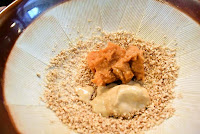

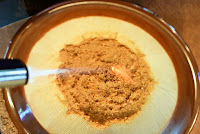


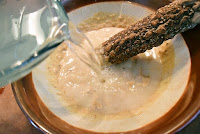

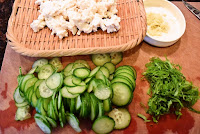

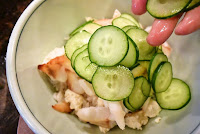

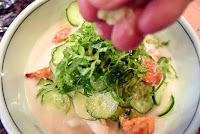
No comments:
Post a Comment